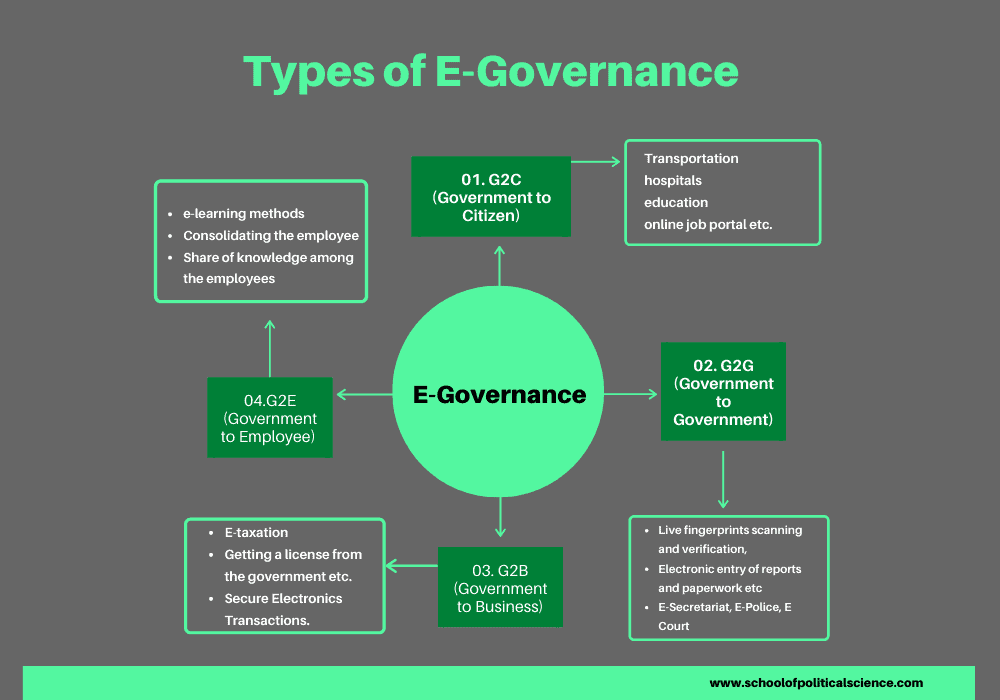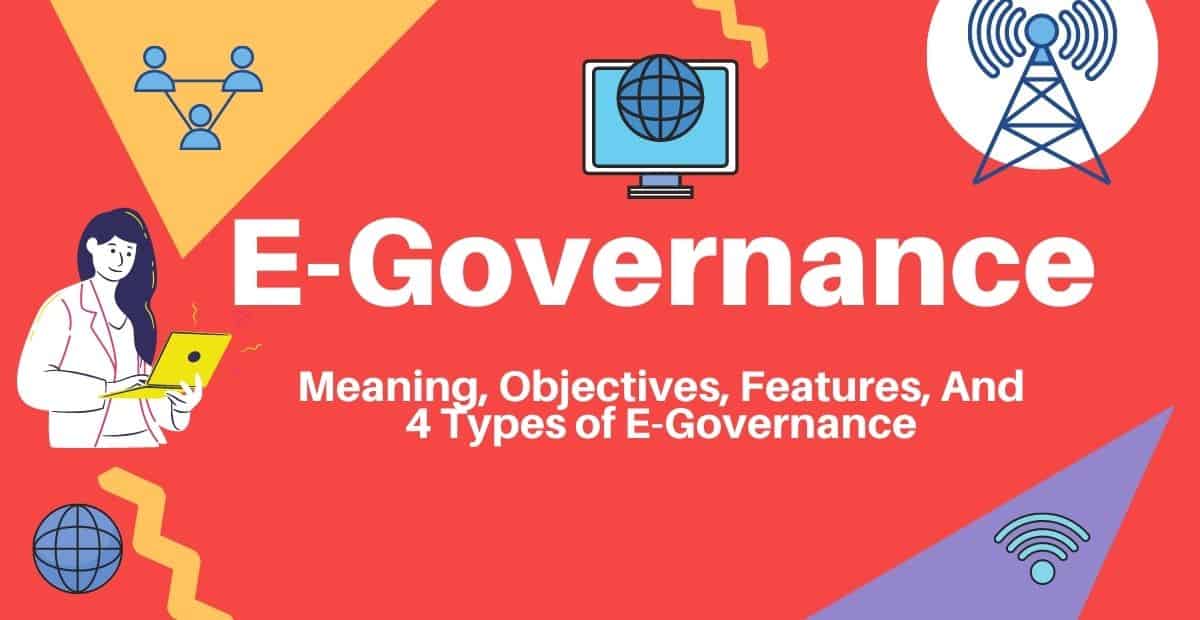One of the most modern initiatives to establish good governance is e-governance. At present, the features of e-governance are observed in almost all developed or underdeveloped developing countries for fostering their developmental process. So its importance in today’s world is immense. Below are the answers to all the questions related to e-governance.
Must Read- Good Governance: Definitions, Characteristics, And Importance
Table of Contents
What is E-Governance or Electronic Governance?
A new paradigm shift has been developed in the field of governance through the application of ICT in the processes of governing called Electronic-Governance or E-Governance.

E-governance raises the transparency, accountability, efficiency, effectiveness, and inclusiveness in the governing process in terms of reliable access to the information within government, between government, national, state, municipal, and local level governments, citizens, and businesses and empowers business through access and use of information (Dwivedi and Bharti: 2005).
The main focus of E-Governance or electronic governance is to provide transparent, equitable, and accountable service delivery to the citizens. The aim of e-governance facilitates and improves the quality of governance and ensures people’s participation in the governing process through electronic means like e-mail, websites, SMS connectivity, and others.
E-governance is not just about government websites or e-mails or financial transactions. “It will change how citizens relate to government as much as it changes how citizens relate to each other” (Katyal: 2002). It also refers to the utilization of IT in the country’s democratic processes itself such as the election.
E-governance is about the use of ICT for steering the citizens and promoting public service. It includes a pragmatic application and usage of ICT for delivering efficient and cost-effective services and information and knowledge to the citizens being governed, thereby realizing the vast potential of the government to serve the citizens (Prabhu: 2015). It made correlations between state and society, government and people, people to people, governance, and society.
To know about governance, read this article– Governance: Meaning, Definitions, 4 Dimensions, And Types.
Objectives of E-Governance
The objectives of e-governance are as follows-
- One of the basic objectives of e-governance is to make every information of the government available to all in the public interest.
- One of its goals is to create a cooperative structure between the government and the people and to seek help and advice from the people, to make the government aware of the problems of the people.
- To increase and encourage people’s participation in the governance process.
- e-Governance improves the country’s information and communication technology and electronic media, with the aim of strengthening the country’s economy by keeping governments, people, and businesses in tune with the modern world.
- One of its main objectives is to establish transparency and accountability in the governance process.
- To reduce government spending on information and services.
Features of E-Governance
It has been proven from the concept of e-governance that it is a powerful means of public service in the present era. Some of its features can be found by observing the functioning of e-governance.
- De bureaucratization: Due to e-governance, the gap between the people and the government in all the services of the government is narrowing and the dependence of the people on the bureaucracy is also greatly reduced.
- E-Services: Its main feature is the provision of services through the Internet. As a result, we get G2C, G2B, G2E, etc. services. This is already discussed in the section on ‘types of governance’.
- International Services: through e-governance, all the essential services can be delivered to the citizens who are living outside of their country for job purposes or any other reasons.
- It enhances the right to express to the citizens. Using the means of e-governance anyone can share their views with the government on any bill or act or decision taken by the government.
- Economic Development: With the introduction of e-governance, various information like import-export, registration of companies, investment situations, etc. are available through the Internet. As a result, time is saved, procrastination decreases, and economic dynamism increases.
- Reduce inequality: using e-governance tools everyone can gather information and empower themselves. In this globalized world, knowledge is power, and means of e-governance empower us by providing relevant information at minimal cost, effort, and time.
Types of E-Governance
E-Governance can be considered as the socially inclusive policy for the development of transparency and accountability of both people in society and administration. This policy involves providing services to the people with the collection of information through institutional and communicational development.

It provides quality services in several ways. Those ways are also called types of e-governance. These are mentioned below-
- G2C (Government to Citizen)
- G2G (Government to Government)
- G2B (Government to Business)
- G2E (Government to Employee)
1. G2C (Government to Citizen)
As people are the key concept of politics and government as well as governance, the government is compelled to connect with citizens through a transparent and accountable order. In this connection, the government is responsible for promoting social opportunities and public services in the field of-
- Transportation (Registration of motor vehicles, Issue of driving licenses, Issue of plying permissions, Tax and fee collection through cash and bank challans and control of pollution, etc.),
- hospitals (linking various hospitals in different parts of the country to ensure better medical services to citizens),
- education ( availability of the e-learning modules to the citizens, right to education),
- online job portal and various customer services.
It also ensures services such as the issuing of certificates, job cards, passports, ration cards, payments of bills, and filing taxes from the doorstep through the e-governance platform. The main objectives of the G2C services are to ensure equitable distribution of information for all, acceptance of citizens’ feedback, and improve welfare services.
2. G2G (Government to Government)
G2G has been referring to raising the quality of the government process by cost-cutting, managing performance, and making strategic connections within the government.
It enables government institutions to be more efficient and more effective through the use of IT tools such as-
- Live fingerprints scanning and verification,
- Electronic entry of reports and paperwork etc.
The major key areas in this type of e-governance are
- E-Secretariat (all the valuable information regarding the function of the government is interlinked throughout the various departments),
- E-Police (police personnel records, criminal records, etc), and
- E-Court (creating a database of all the previous cases, pending and ongoing cases) and Statewide Networks (Kumar: 2011).
3. G2B (Government to Business)
G2B is mainly concerned with these things-
- E-taxation,
- Getting a license from the government etc.
- Secure Electronics Transactions.
It has included the policy of the government with business. According to S.P Kumar, ‘the essentials for the achievement of G2B services for secure and authentic transactions include Standards for electronic transactions, a secure payment mechanism, and Public key infrastructure’ (Kumar: 2011).
4. G2E (Government to Employee)
The G2E model refers to providing information and services from the government to employees and employee to the government as well. It involves training through-
- e-learning methods;
- Consolidating the employee and
- Share of knowledge among the employees.
It has also facilitated the employee to access information regarding pay and benefits policies and manage their profits through online.
Must Read- New Public Management: Meaning, 10 Principles, and Features
What is the Relation Between ICT and Governance?
Through the application of ICT in public administrations, the governing processes are more effective and more efficient and also ensure sustainable development.

Through ICT “new forms of dialogue and collaboration among public, private and civil society organizations enhance transparency and accountability that can create conditions of fair and open while expanding access so that everyone can participate and benefit from today’s knowledge-based economy” (Bhattacharya: 2013).
The use of ICT in all aspects of governance can remove irrelevant human involvement in the processes of service delivery from the government to the citizens.
Hence, ICT has been promoting good governance by increasing transparency, and accountability in public sectors. It helps to foster the process of decision-making and public participation and reinforces fare delivery of goods and services to the people.
In this context, ICT developed the process of the assurance of the citizen’s right to information and functions. Government sectors/institutions had been providing information related to their accomplishments, achievements, programs, and plans through their websites or e-platform to the citizens.
Citizens also can send feedback or query on any plans, or programs that are mostly affected by them from their homes using the ICT tools. Through the online process, people can easily upload and download forms, file taxes, do financial transactions through e-banking services, get jobs through different online job portals, etc.
All countries are interested in fostering the application of ICT in their public administrations for sustainable economic development and transparency.
Must Read- Meaning, Nature, and Scope of Public Administration
World Summit on Information Society focused on-
- An information society for all by improving access to information and communication infrastructure and technologies as well as to information and knowledge;
- Capacity building
- Increase confidence and security in the use of ICTs;
- Create an enabling environment at all levels;
- Develop and widen ICT applications; foster and respect cultural diversity; recognize the role of the media;
- Address the ethical dimensions of the Information Society, and encourage international and regional cooperation.
Conclusion
From the above discussion on E-Governance: Meaning, Objectives, Features, and Types, it can be stated that In this era of globalization, the role of E-governance is significant. This is a blessing, especially to third-world countries. As a result of the implementation of e-governance, all these countries have been able to maintain their development trend on par with the developed countries. Knowledge is power. E-governance empowers us by providing relevant information at a minimal time, cost, and price.
References
- Dwivedi and Bharti (2005): ‘E-Governance in India- Problems and Acceptability’, Journal of Theoretical and Applied Information Technology, New Delhi, Pp. 37-42.
- Bhattacharya, M. (2013). New Horizons of Public Administration. New Delhi: Jawahar Publishers.
- Katyal, N. (2002). “The white box revolution”. Data Quest, Special Issue Vol.XX, No: 14, July 31, 2002, pp.II-IV.
- Kumar, P and Kumar, D &et al. (2013). ICT in Local Self Governance: A study of Rural India. International Journal of Computer Applications. Retrieved February 23, 2018, from https://arxiv.org/ftp/arxiv/papers/1401/1401.0591.pdf.
- Kumar, S.P. (2011). E-Governance and Decentralized Planning in Kerala. Retrieved February 25, 2018, from http://hdl.handle.net106038482.
- Subramanian, C. (2012). E-Governance: A Key to Good Governance in India. International Journal of Recent Scientific Research. Retrieved March 3, 2018, from http://recentscientific.com/sites/default/files/Download_228.pdf.


1 thought on “E-Governance: Meaning, Objectives, Features, and 4 Types”